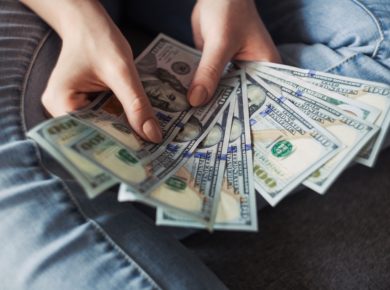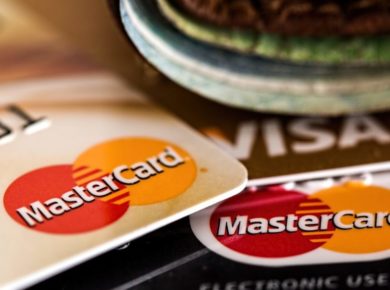Who doesn’t love a good underdog story? It’s almost impossible not to root for the hero or heroine who’s down on their luck and somehow beats the odds to win in the end. Whether it’s Rudy taking the field at Notre Dame or Helen Keller’s incredible journey, motivational stories make us feel good and give us hope.
Not all of these stories are made for Hollywood. Some anecdotes are simply stories of perseverance, and those examples should be just as motivational. When we hear unbelievable stories of triumph, like Stephen Hawking living as long as he did and creating such waves in the world of science, that might not resonate as much as the tale of a person who got laid off and then went on to start a million dollar business. I don’t know about you, but those stories of financial triumph sure make me want to work harder.
There are plenty of examples of people who started with next to nothing and ended up on top of the world. I’ve chosen five, some better known than others, and I’m hoping you’ll find ways to relate to these stories. You won’t have the exact same path as these famous figures, but you can absolutely learn from their trials and victories. If nothing else, this might give you some fodder to make you sound smart during your water cooler conversations.
1. Dave Ramsey
This guy is one of the most widely known financial voices in the world. Between his books, radio shows and podcast, it’s hard to find people who don’t know who Dave Ramsey is. However, unless you dig a little deeper into Dave’s story, you might not know that he was no financial guru until after a delightful round of bankruptcy.
Ramsey’s first book, Financial Peace, was as much a result of his failure as it was his success. That’s an important thing to note with a lot of rags-to-riches icons – their biggest successes directly result from their biggest failures. That was certainly the case with Dave Ramsey.
Before he turned 30, Ramsey had become a very wealthy man. He made gobs of money through rental properties and his company was doing ridiculously well. However, changes in tax policy and lending practices put a quick end to those good times. When a bigger bank bought out one of Ramsey’s lenders and asked him to immediately settle up a $1.2 million debt, there was no choice but to file for bankruptcy.
Once the downward spiral stopped and he started getting back on his feet, Ramsey didn’t dive back into the world of real estate. Maybe he was gunshy or maybe he just didn’t have the desire to play those same old games. Instead, he started attending seminars and learning more about finance, even though he already had a lot of knowledge from his firsthand experiences. Eventually, he started talking to and counseling members of his church, and his career as an advisor began. Writing Financial Peace only happened because clients told him to advise a bigger audience – now his audience is about as big as it can get.
The biggest takeaway from Dave Ramsey’s story is the power of determination. After watching his real estate empire collapse, he came at life and finance in a whole new way. He combined his own lessons with teachings from others and became one of the most well-known personalities in the country. Ramsey knew plenty before he filed for bankruptcy, but you better believe that process taught him some of the most important lessons.
Failure isn’t fun, but few things educate us better than getting it wrong the first time. If you’re sitting around wishing you could be as rich and successful as Dave Ramsey, keep in mind that he had to bottom out in order to get there.
2. Do Won Chang
If you’re a fan of American Dream stories, Do Won Chang’s career and the beginning of Forever 21 clothing stores is right up your alley.
Chang, who was born in 1954, came with his family to the United States in the early 1980s. Many of you should be inspired already, as the man was already in his late 20s when he moved from South Korea and started working as a dishwasher. Since dishwashing didn’t cover all the bills, he also got work as a gas station attendant and started a cleaning service.
The work Chang did in the early going is important for two reasons. First, it shows some pretty exceptional work ethic to balance three jobs in hopes of making ends meet. Second, Chang made the most out of the work he was doing. He started washing dishes because it was the first job he could find, but added cleaning to the career list so he could spend time around successful professionals. When he was working at the gas station, he’d strike up conversations with people who drove fancy cars to find out what they did. This interest and effort is what pointed him toward the fashion industry.
Seeing that people in Los Angeles were making plenty of cash in clothing, Chang and his wife, Jin Sook, moved into that industry using the $11,000 they had in savings. 11 grand went a lot farther back in the mid-80s than it does today, but it wasn’t like the Changs were sitting on a mountain of money when they opened their first clothing store.
Selling wholesale allowed Forever 21 (then called Fashion 21) to bring in plenty of customers and begin expanding. Now this small family business has hundreds and hundreds of stores and employees. Also, Chang’s wealth is in the billions.
There’s another inspirational component to Chang’s story, beyond starting with nothing and building a massive, extremely lucrative business. When the economy tanked in 2008, the response of most business owners was to hoard pennies and cut costs while hoping to weather the storm. The Changs did the opposite, opening new stores and adding thousands of jobs each year. This helped the company and helped the country, and it shows that sticking to your guns and acting with conviction usually leads to good financial results.
I’m sure there’s a lot of luck and good fortune involved in the story of Do Won Chang, but my main takeaway is the opportunist mindset that helped him achieve so much after starting with so little.
3. Walt Disney
At 22, Walt Disney had to take out a family loan in order to start a business. The most fascinating part of this is that his family was willing to lend the money, as Walt’s first company had declared bankruptcy just two years before.
Animation was always the game plan for one of the world’s most famous cartoonists. And even though the skill was always there, the positive response and the revenue was not. Disney was a teenager when he started his first animation studio. Unfortunately, he wasn’t prepared to find a good financier at that age, and his financial backer went broke just after Disney had hired a staff. He wasn’t even out of his teens before Walt Disney had to declare bankruptcy.
I imagine there were lots of voices of descent in those early years, telling Walt he couldn’t make money as an artist and it was time to move on. If those voices had been more influential, we all know how many classic icons would have never graced our televisions. Disney delivered Mickey Mouse in 1928, eight years after his first business failed and six years after he got his family loan. That’s six years of toiling and fighting back doubt that must have nagged at the animator.
After Mickey, Disney wasn’t on easy street. The cost to make Snow White and the Seven Dwarves ended up being three times higher than the budgeted amount. Mickey Mouse was already a household name, and yet Disney was looking at another bankruptcy and his first feature film was about to be thrown out. Fortunately, a last-minute loan pushed production forward, and the rest is history. Snow White went on to be the most successful film in 1938, and the Disney brand is as recognizable as any on the planet.
Think for a second of what Walt Disney fought through in order to achieve his fame: he went bankrupt when he was barely an adult and the world was in the midst of the greatest war to that point. He had every reason to throw in the towel, but that was never an option for him. Even after some success, he still had to fight studios and beg lenders in order to release what went on to be an unprecedented hit.
It was 18 years between Disney’s brush with bankruptcy and his launch into the stratosphere. Try to remember that the next time you feel like something is taking too long to pan out. If it’s really worth doing, it’s definitely worth waiting for.
4. Gabrielle Chanel
Chanel rolls right off the tongue and is an immediately recognizable corporation. But do you know anything about the young orphan who went on to change the world of fashion forever?
Born in France in 1883, Gabrielle Chanel was sent to an orphanage when she was 12 after her mother died. She became a skilled seamstress during her time in the orphanage, a skill that she used to make some money when she finally went out on her own. She also sang in a cabaret, which is where she met and became the mistress of a wealthy heir. Spending time in the upper crust of French society, Gabrielle Chanel’s story took a very literal rags-to-riches turn; she was seeing the fanciest of ladies fashion for the first time, and also noticing how difficult it was for women to move in this apparel.
Using her new relations and ever-improving social station, she was able to open a hat shop (she had learned millinery as a hobby). A well-known actress wore one of her hats in a production, which was all the marketing Chanel needed at the time. As business picked up, she started working on casual attire that looked good and could be worn comfortably. This sounds like the goal of every modern clothing company, but it was very novel back in the early 20th century.
The brand grew and grew, adding more and more lines and products, and Chanel is now so big that most people can’t imagine it was started by a single person. Gabrielle was heavily involved in her company and the fashion world until she died in 1971.
We have a habit of dismissing dreams that don’t seem plausible. For some, the idea of opening a store seems impossible, because the funding isn’t there or the process is too foreign. It’s hard to think of a more implausible story than that of Gabrielle Chanel, who was born to poor parents and later orphaned, then made money as a cabaret singer before entering elite circles as a mistress. The deck was stacked against Chanel from the start, and yet here were are, knowing without a doubt that she started a global enterprise that helped change the world of fashion forever.
5. J.K. Rowling
The Harry Potter creator’s story is fairly well known, but I think it’s important to bring a more recent success into the conversation. If you’re 30 years old, you probably didn’t know about J.K. Rowling or Harry Potter when you were 10. Since then, Rowling became the first billionaire author and one of the ultimate rags-to-riches stories.
Rowling was working as a researcher and a secretary in the early 1990s when she first came up with the Harry Potter storyline. During the next seven years she would lose her mother, get married, have a child and then almost immediately get divorced. Rowling was a single mother with virtually no money, working on a manuscript at coffee shops while her baby slept. The next time you don’t feel like you have enough time to do something meaningful, take a deep breath and tell yourself you’re wrong. we can always find time.
Most people know Rowling was poor and depressed before a publishing company finally bought her book, but not everyone knows the manuscript was rejected 12 times before becoming the first in a series of books that would sell a few zillion copies. How many of you have been rejected 12 times for the same thing? That takes a lot of gumption to push through, and that’s why J.K. Rowling is one of the greatest success stories. Do you have an awesome idea that people have critiqued and made you doubt? If you believe in what you’re doing, you need to persevere.
Some people mistakenly believe that Rowling started Harry Potter after her divorce and losing her job. The idea for the story had been brewing for years prior, and the events in her life helped shape the finished product. She started writing in 1990 and it wasn’t until 1997 that the first book would be published.
There are a lot of parallels with these different stories of success, and one that I’m especially drawn to is that these people found their stride after living through hard times. Ramsey and Disney went bankrupt, Chang moved to a new country and was working three thankless jobs, Chanel lived six years in an orphanage and Rowling was on the verge of raising a toddler as a homeless woman. Out of these dire situations, these people found the drive to improve their lives and then never looked back.
Don’t take this to mean you have to live through the worst to experience the best; you’re free to start walking the road to success at any point. However, if you are going through a rough patch, wondering why life is so hard and what you’ve done to deserve this fate, don’t give up hope. If you show resolve, you too can beat the odds and do great things.
If you hear about Dave Ramsey or J.K. Rowling and start thinking of reasons why you could never experience the same success, stop yourself. You’re not meant to have the same story or the same achievements. The success you bring into your life will be entirely your own, but it can be motivated by people from different walks of life. You might not have financial expertise, but Dave Ramsey’s story could inspire you to use personal experiences and teach others. Maybe you don’t design hats, but Gabrielle Chanel’s story is an excellent example of how a hobby can become an empire.
You need motivation to take action and make your dreams come true. I find stories like these very inspirational, and hopefully some of you will as well.






